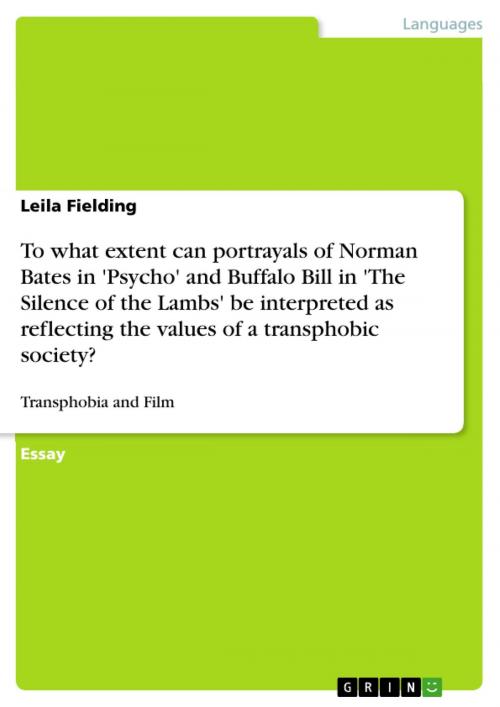To what extent can portrayals of Norman Bates in 'Psycho' and Buffalo Bill in 'The Silence of the Lambs' be interpreted as reflecting the values of a transphobic society?
Transphobia and Film
Nonfiction, Entertainment, Drama, Anthologies| Author: | Leila Fielding | ISBN: | 9783656291497 |
| Publisher: | GRIN Verlag | Publication: | October 17, 2012 |
| Imprint: | GRIN Verlag | Language: | English |
| Author: | Leila Fielding |
| ISBN: | 9783656291497 |
| Publisher: | GRIN Verlag |
| Publication: | October 17, 2012 |
| Imprint: | GRIN Verlag |
| Language: | English |
Essay from the year 2012 in the subject English - Miscellaneous, grade: 80 (1:1), , language: English, abstract: Transphobia can be defined as fear, disgust, stereotyping, or hatred of transgender, transsexual and other gender non-traditional individuals because of their perceived gender identity, expression, or status. Transgender is an umbrella term denoting or relating 'to a person whose self-identity does not conform unambiguously to conventional notions of male or female gender.' Transsexual refers to a person either pre-op or post-op. A transvestite or cross dresser can be defined as a person of either sex who derives erotic pleasure from cross-dressing. Gender should be understood to mean the 'hetero-normative' social and cultural codes of masculinity and femininity, rather than the biological male/female anatomical sex. Although the essay focuses on two films containing transgender serial killers, it must be noted (in order to understand the extent of the stereotype) that many more depictions of transgender killers exist in the horror/thriller genre: Dressed To Kill (1980), Cherry Falls (2000) and Sleepaway Camp (1983) to name just a few. The essay addresses depictions of transgender identities in connection with derogatory stereotypes and consequently hopes to reveal a correlation between public perceptions associated to transgender individuals and the way in which they are portrayed on screen.
Essay from the year 2012 in the subject English - Miscellaneous, grade: 80 (1:1), , language: English, abstract: Transphobia can be defined as fear, disgust, stereotyping, or hatred of transgender, transsexual and other gender non-traditional individuals because of their perceived gender identity, expression, or status. Transgender is an umbrella term denoting or relating 'to a person whose self-identity does not conform unambiguously to conventional notions of male or female gender.' Transsexual refers to a person either pre-op or post-op. A transvestite or cross dresser can be defined as a person of either sex who derives erotic pleasure from cross-dressing. Gender should be understood to mean the 'hetero-normative' social and cultural codes of masculinity and femininity, rather than the biological male/female anatomical sex. Although the essay focuses on two films containing transgender serial killers, it must be noted (in order to understand the extent of the stereotype) that many more depictions of transgender killers exist in the horror/thriller genre: Dressed To Kill (1980), Cherry Falls (2000) and Sleepaway Camp (1983) to name just a few. The essay addresses depictions of transgender identities in connection with derogatory stereotypes and consequently hopes to reveal a correlation between public perceptions associated to transgender individuals and the way in which they are portrayed on screen.















